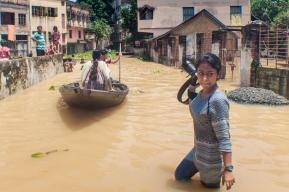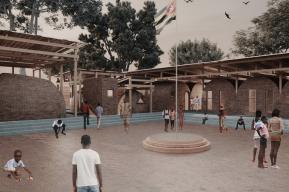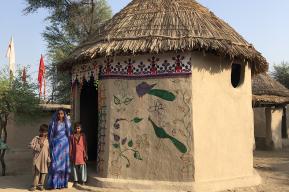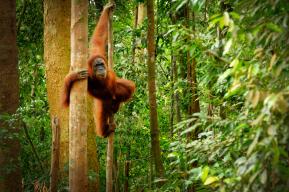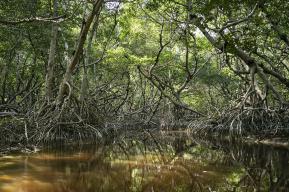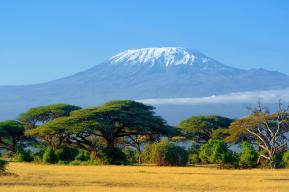مقال
الشعوب الأصلية، رقيب مستنير للتنوّع البيولوجي

إنّ أكثر من ربع الأراضي في العالم تملكها الشعوب الأصلية أو تتصرّف فيها أو تقيم عليها. لكنّ معارف هذه الشعوب نادراً ما يتم أخْذها في الاعتبار من قِبل الباحثين وأصحاب القرار رغم ما تُحظى به من اعتراف متزايد.
بيتر بايتس
وحدة الإسناد التقني للمنبر الحكومي الدولي للعلوم والسياسات في مجال التّنوع البيولوجي وخدمات النّظم الإيكولوجية حول المعارف المحليّة ومعارف الشّعوب الأصليّة- برنامج نُظُم المعارف المحليّة ومعارف السكّان الأصليّين، اليونسكو
براسرت تراكونسوفاكون
جمعية بغاكينياو Pgakenyaw للتنمية المستدامة، تايلاندا
منذ مئات السّنين، يمارس سكّان قرية كارين، في هين لاد ناي، الواقعة في قلب الغابات الخصبة بمحافظة تشيانغ راي، شمال تايلاند، الزّراعة المتنقّلة أو الدّورة الزراعيّة بالتناوب على الأراضي. وهذه التقنية الزّراعية المستدامة القائمة على قطع الأشجار والنّبات وحرقها -والتي تعرّضت، في وقت معيّن ودون وجه حقّ، إلى الانتقاد بدعوى تأثيرها على تغّير المناخ- تُستخدم لاستصلاح الأراضي وإعادة إحيائها.
يتمّ قطع الأشجار والنّبات داخل مقاسم غابيّة صغيرة، قبل إحراقها بعناية، مع السّيطرة على النّيران، وتحويلها إلى سماد لتغذية التّربة. ثم تُزرع محاصيل متنوّعة لفترة محدودة، ويتمّ بعد ذلك تبوير الأراضي (أي تركها ترتاح). وفي النّهاية، تنمو الغابة من جديد ثمّ تتكرّر الدّورة باستمرار.
هكذا، تُنشئ المجتمعات موائل حرجية عديدة ومتلاصقة في شكل فسيفساء تتميّز بأطوار متراوحة بين الزراعة وإعادة النّمو. وفي الوقت الذي يتناقص فيه النّحل الدّاجن في العالم بأسره، تزدهر ثلاثة أنواع من النّحل البرّي في هين لاد ناي. أمّا العسل الذي يتم جنْيه في الأراضي البور فهو ذو نوعيّة أفضل من نوعية عسل الغابات، ويُباع في الأسواق التايلاندية.
وليس مثال القروييّن في هين لاد ناي سوى واحد من بين عديد الأمثلة الأخرى. فقد أصبح مناصرو حماية البيئة أكثر وعياً بالدّور الذي تضطلع به الشعوب الأصلية في الدّفاع عن تراثها الطبيعي. هذا وقد حُظيت المعارف الإيكولوجية التقليدية المتعلّقة بمكافحة استنزاف التنوعّ البيولوجي العالمي باعتراف واضح من قِبل التقييم العالمي الصّادر عن المنبر الحكومي الدولي للعلوم والسياسات في مجال التنوع البيولوجي وخدمات النّظم الإيكولوجية، والذي نشر في مايو 2019.
وتدعم اليونسكو، منذ أمد بعيد، هذا التوجّه، ولاسيّما عن طريق البرنامج المعني بنُظم المعارف المحلّية ومعارف السكّان الأصليّين (LINKS)، الذي يأوي وحدة الإسناد التّقني للمنبر الحكومي الدّولي للعلوم والسّياسات في مجال التنوّع البيولوجي وخدمات النّظم الإيكولوجيّة (IPBES).
معارف ضاربة في أعماق التاريخ
يعيش العديد من الشّعوب الأصلية في مناطق منعزلة وكثيراً ما تكون غنيّة جداً بالتنوّع البيولوجي، حيث يتطلّب العيش إيجاد توازن مع الطّبيعة من أجل البقاء.
وبفضل ما تمتلكه هذه الشّعوب من دقّة الملاحظة، غالباً ما تكون قادرة على الرّبط بين مختلف الظّواهر في علاقة بتطوّر النّظام الإيكولوجي من قبيل تغيّر الظّروف المناخيّة أو وصول أجناس جديدة. فمثلا، أتاحت مئات السنين من مراقبة أمواج التسونامي من طرف شعوب الموكين، القاطنين في بحر أندمان على طول السّاحل الغربي لتايلاند، البقاء في أمان عندما ضرب التسونامي القاتل قُراهم في عام 2004.
هذه المعارف تسمح أيضا بمعرفة التوقّعات الموسمية إذ في مقدور رعاة الماشية، بشرق إفريقيا، توقّع توقيت قدوم الأمطار ومكان نزولها من خلال ملاحظة إزهار الأشجار وسلوك الحشرات والطّيور. ويتمّ رصد هذه المؤشرات البيولوجية من قِبل كشّافين يجوبون الأقاليم لتحديد الزّمن والمكان الملائمين لتنقّل قطعان البقر.
كما أنّ هذه المعارف المحلية ليست جامدة بل تُدرج في الحسبان الظّواهر الجديدة التي تطرأ على البيئة. فالأمم الأولى لشمال كندا لاحظت تغيّرات في سلوك قطعان الذئاب عند اصطياد الفريسة وفي دينامية القطعان ذاتها في علاقة بانخفاض أعداد حيوان الرنّة. وهي تغيّرات طرأت بسبب مدّ الطّرقات وخطوط الأنابيب التي تعبر، حاليا، غاباتهم وتقسّمها.
حيوانات، ونباتات، وأرواح
إنّ نُظُم المعارف التّقليدية تحكم علاقات البشر بالتّنوّع البيولوجي. ففي نظر هذه الشّعوب، تشمل "الطّبيعة"، في أغلب الأحيان، الحيوانات، والنّبات، والأرض، والبشر، والأرواح. ووفقاً لهذا التّصور، لا يُعتبر البشر أعلى منزلة من الطّبيعة، كما أن الطّبيعة لم توجد لأجل إخضاعها إلى البشر.
وترى بعض المجتمعات الأصلية أنّ الحيوانات بمثابة الهِبَة التي تُقدّم إلى الصّيادين، لذا فهي تحظى باحترام واعتزاز يتجسّدان في طقوس معيّنة، وتُوزّع لحومها بين أفراد المجتمع وعلى الحيوانات الأخرى كما هو الشأن، بالخصوص، لدى صيّادي الحيتان الضّخمة في الآلسكا. فهذه الشعوب الأصلية تعيش وفق منظومة مؤسّسات عرفية معقّدة، وقواعد، ومحرّمات، ترشدها وتنظّم علاقاتها بالبيئة التي تعيش فيها.
بيد أن الشعوب الأصلية في العالم بأسره توجد في الخطوط الأمامية للتغيّرات البيئية والاجتماعية. فالزّراعة، واستغلال الغابات، والتّنمية الصناعية، أنشطة تُلحق الضّرر، على نحو متزايد، بمناطق التنوّع البيولوجي الغنيّ، بل تدمّرها أحيانا؛ حيث يتمّ، في غالب الأحيان، مصادرة أراضي الأجداد أو الاستيلاء عليها وتحويلها إلى حيازات زراعية أحادية المحاصيل. ومثل هذه الممارسات تقترن، أحيانا، بأعمال عنف تجاه السكّان الأصليين. ومن تبعات ذلك، أيضا، زيادة تلوّث المياه، والاستغلال المشطّ للحيوانات والنّبات بما يفضي إلى ندرة الأغذية واضطراب سبل العيش التقليدية.
وعلى صعيد آخر، فإنّ الجهود الرّامية إلى إدماج الشعوب الأصلية في المجتمعات الوطنية يشكل، بدوره، تهديداً لنمط حياة هذه الشعوب. فالتعليم في شكل دروس تُلقى داخل قاعة الدّرس لا يساعد على نقل المعارف عن القدماء. ومن المفارقة أن الجهود المبذولة لحفظ التنوّع البيولوجي، من قبيل إنشاء مناطق محميّة أو منع استغلال بعض الأنواع، قد تشكّل تهديداً إضافيا في ظلّ منع هذه الشّعوب من النّفاذ إلى الموارد الغذائيّة والفضاءات التّقليدية.
تعليم يتكفّل به القدماء
هناك الكثير من المعارف التي يمكن تعلّمها من الجماعات المحلية الأصلية، إلاّ أنّ العلوم الغربية غالبا ما تجد صعوبة في أخذ هذه المعارف التّقليدية بعين الاعتبار نظرا لكونها شفويّة، في معظمها، أو تستند إلى الخبرة العمليّة، في حين ينزع الباحثون وأصحاب القرار إلى اعتماد الوثائق المكتوبة بشأن معارف الشّعوب الأصلية بدلاً من الارتباط بهذه الشّعوب نفسها.
على أنّ هناك عدد متزايد من المبادرات الإيجابية في مجال التّعاون مع الشّعوب الأصليّة في مجالات البحث، والتّعليم، وإدارة، التنوّع البيولوجي واتّخاذ القرار في شأنه، وما يفترض التّعامل مع هذه الشعوب الأصلية كشريك بالكامل.
وبدلاً من أن تكون هذه الشعوب مواضيع بحث، فبإمكانها أن تتحوّل إلى شريكة في صياغة مشاريع بحثية من خلال تناول قضايا، ومنهجيات، ونتائج ذات دلالة ومعنى بالنسبة لها. مثال ذلك مشروع تبادل المعاينات والمعارف في منطقة القطب الشمالي (ELOKA) المتعلّق بمعارف شعوب الإنويت الأصليين حول طبقات الجليد البحري.
كما يمكن إعداد برامج مدرسية من طرف هذه الشعوب ولصالحها بغاية تشجيع المعارف عن كوكب الأرض، وجعلها تُدَرّس من طرف القدماء بدلاً من تعليمها في قاعات الدّرس. وقد بادرت الشعوب الأصلية بكندا والجماعات الأصلية في هاواي بالولايات المتحدة بوضع هذه المقاربة محلّ اختبار.
لقد حان الوقت لكي تسيطر الشعوب الأصلية بالكامل على عملية اتخاذ القرارات المتعلقة بأراضيها، ومواردها المائية، ومجتمعاتها المحلية بما يتيح لها تطبيق معارفها في مجال تنفيذ القرارات التي تعود بالنّفع على التنوّع البيولوجي. والأكيد أنّ التّداعيات المنتظرة من هذا الخيار، سواء على الأشخاص أو على كوكب الأرض أو على التنوّع البيولوجي، سوف تكون عظيمة.
محميات المحيط الحيوي: التعبئة من أجل التصدي لإزالة الغابات الأمازونية
مطالعات ذات صلة
التكنولوجيات المتقدمة على طريقة سيكو، رسالة اليونسكو، يناير- مارس 2019
أرزّ وسمك وبطّ في تناسق مع البشر، رسالة اليونسكو، يناير- مارس 2019
لنُصغ إلى نداء البحيرة، رسالة اليونسكو، أبريل- يونيو 2018
اشترك في رسالة اليونسكو لمتابعة الأحداث. الاشتراك في النسخة الرقمية مجاني %100.
By Peter Bates and Prasert Trakansuphakon
The Karen inhabitants of the village of Hin Lad Nai, nestled in the lush forests of Chiang Rai province in northern Thailand, have practised rotational shifting cultivation for centuries. This sustainable slash-and-burn cultivation technique – once mistakenly criticized for contributing to climate change – has been used around the world to regenerate the land and support biodiversity.
Small patches of forest are cleared of trees and shrubs, before controlled burns are undertaken, to put nutrients back into the soil. A diverse range of crops is then planted for a limited period, after which the area is left fallow, or allowed to rest. Eventually, the forest grows back, and the cycle is repeated.
In this way, the community creates a mosaic of habitats in the forest, with different stages of farming and regrowth. At a time when honeybees are declining worldwide, three different species of wild bees are thriving in Hin Lad Nai. The honey harvested from fallow areas is of a higher quality than that from the forest, and is sold at markets across Thailand.
The case of the villagers of Hin Lad Nai is just one example of many. Environmentalists are becoming increasingly aware of the role that indigenous peoples play in defending their natural heritage. The importance of harnessing their traditional ecological knowledge to defend the earth’s depleting biodiversity was clearly recognized by the Global Assessment Report of the IPBES, released in May 2019.
The importance of harnessing traditional ecological knowledge has been recognized
UNESCO has long supported this initiative, particularly through the LINKS programme, which hosts the IPBES technical Support Unit on Indigenous and Local knowledge.
Centuries of knowledge
Many indigenous communities live in isolated and often highly biodiverse areas, where living in balance with nature is crucial for survival. As keen observers of their environments, indigenous peoples often possess knowledge linking various phenomena to ecosystem change – changes in weather patterns, for example, or the impacts of new species coming into their territories.
For example, centuries of knowledge about tsunami waves allowed the Moken or “sea nomads” of the Andaman Sea along the west coast of Thailand to stay safe when the deadly tsunami struck their villages in 2004.
This knowledge is also used to make seasonal forecasts and predict weather patterns. The pastoralists of East Africa are able to predict when and where the rains will fall – by observing the flowering patterns of trees, and the behaviour of insects and birds. These biological indicators are observed by scouts roaming the landscape, to determine where and when the cattle herds should move.
This indigenous knowledge is not static. It is constantly being enriched to include knowledge of new phenomena that affect the environment. The First Nations communities in northern Canada have observed changes in the hunting behaviour and pack dynamics of wolves, and consequent declines in caribou populations. These changes are attributed to the roads and pipelines that now dissect their forests.
Animals, plants and spirits
Indigenous knowledge systems include values for managing the relationship of humans with biodiversity. In their conception, “nature” often includes animals, plants, the earth, humans and spirits – all tied in reciprocal kinship relationships. Humans are not considered superior to nature, and nature does not exist to serve humans.
For some indigenous communities, animals are believed to present themselves as gifts to hunters – gifts to be respected and cherished through rituals. The meat is shared with other community members and animals, as seen notably in whaling communities in Alaska. A complex system of customary institutions, regulations and taboos serve to inform and regulate their relationships with their environments.
However, today indigenous peoples globally find themselves on the front lines of environmental and social change. Agriculture, logging and industrial development increasingly damage or destroy highly biodiverse areas, and ancestral lands are often seized or invaded and converted to farms and monocrop plantations. These interventions are sometimes accompanied by violence. Waters are increasingly polluted, and animals and plants are harvested at unsustainable rates, leaving little for indigenous communities to eat, and disrupting traditional livelihoods.
Efforts to integrate indigenous populations into national societies also threaten their way of life. Formal education with teachers in classrooms can reduce opportunities to learn on the land with elders. Paradoxically, efforts to conserve biodiversity, such as establishing protected areas or imposing bans on harvesting some species, can also prove to be a threat – as they can prevent indigenous people from accessing food and traditional spaces.
Educated by the elders
Indigenous communities have much to teach us. But efforts to integrate indigenous knowledge into western science are often unsuccessful, as it is largely oral or experiential. Researchers and decision makers tend to consult written records of indigenous knowledge, rather than engaging with the people themselves.
Even so, there are a growing number of good examples and best practices for collaborations with indigenous peoples around biodiversity research, education, management and decision-making. But these examples often hinge on indigenous peoples being considered equal partners.
There are a growing number of collaborations with indigenous peoples
Rather than subjects to be researched, indigenous communities can be supported to be designers of research projects – developing questions, methodologies and results that make sense to them. The Exchange for Local Observations and Knowledge of the Arctic (ELOKA) project, which works with the indigenous knowledge of the Inuit around sea ice, is an example of this.
School curricula can be developed by and for indigenous peoples, to encourage and facilitate learning on the land from elders, rather than only in classrooms. This approach is being increasingly explored by Canada’s First Nations communities, and the Native communities of Hawaii in the United States.
It is now time for indigenous peoples to have full control over decisions affecting their lands, water resources and communities, so that they can directly apply their knowledge to implement decisions that are biodiversity-friendly. Where this can be achieved, the benefits to people, the planet, and biodiversity will be considerable.
Peter Bates
Intergovernmental Science-Policy Platform on Biodiversity and Ecosystem Services (IPBES)
Technical Support Unit on Indigenous and Local Knowledge, UNESCO.
Prasert Trakansuphakon
Pgakenyaw Association for Sustainable Development, Thailand.

In the same issue



